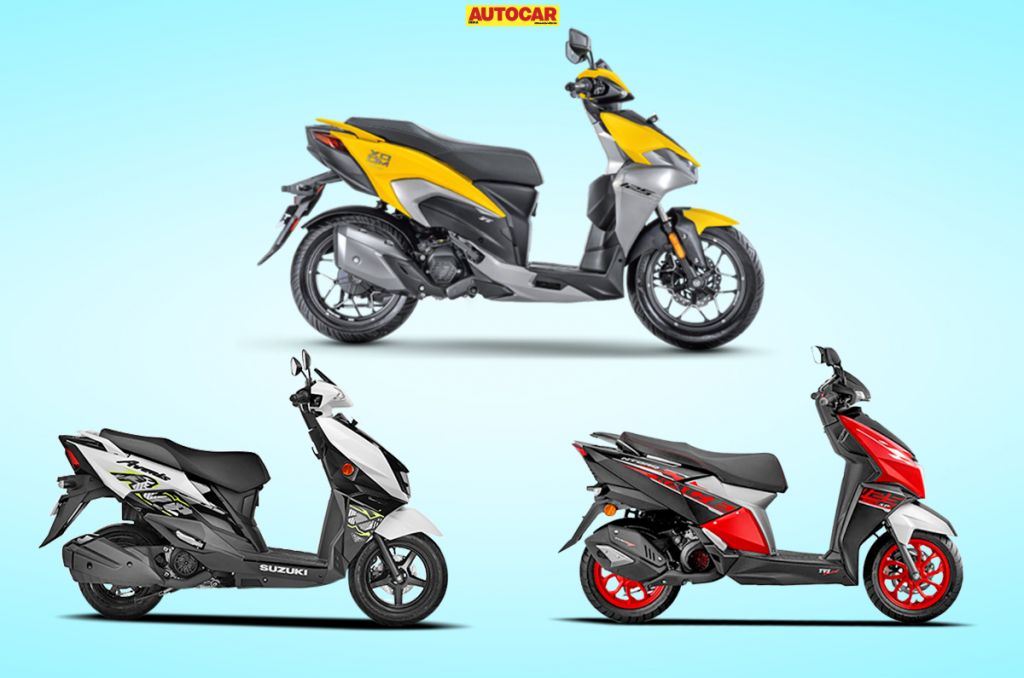
The 125cc scooter segment in India has been the first choice for buyers who want a bit of performance while maintaining practicality. All three scooters compared here have a sporty edge to them and stray away from the conventional design of a 110cc scooter. We compare the latest entrant from Hero, the Xoom 125 in terms of specifications with its chief rivals.
Hero Xoom 125 vs Suzuki Avenis vs TVS Ntorq 125: engine and output
| Engine and output | |||
|---|---|---|---|
| Hero Xoom 125 | Suzuki Avenis | TVS NTorq 125 | |
| Engine | 124.6cc, single cylinder, air-cooled | 124.3cc, single cylinder, air-cooled | 124.8, single cylinder, air-cooled |
| Power | 9.7hp at 7250rpm | 8.5hp at 6750rpm | 9.3hp at 7000rpm |
| Torque | 10.4Nm at 6000rpm | 10Nm at 5500rpm | 10.6Nm at 5500rpm |
The Hero Xoom 125’s air-cooled motor produces the most power at 9.7hp, it’s a whole 1.2hp higher than Suzuki’s Avenis. In terms of torque, the Ntorq 125 is rated to produce 10.6Nm and while this number is marginally higher than the rest, each one of them produces around 10Nm.
Hero Xoom 125 vs Suzuki Avenis vs TVS Ntorq 125: weight and dimensions:
| Weight and dimensions | |||
|---|---|---|---|
| Hero Xoom 125 | Suzuki Avenis | TVS NTorq 125 | |
| Seat height | 777mm | 780mm | 770mm |
| Ground clearance | 164mm | 160mm | 155mm |
| Wheelbase | 1327mm | 1265mm | 1285mm |
| Fuel capacity | 5 litres | 5.2 litres | 5.8 litres |
| Weight | 121kg(Disc), 120kg (Drum | 106kg | 111kg |
Here, the Xoom 125 turns out to be the heaviest at 121kg. Irrespective of the variant, it has a substantial weight difference compared to the Avenis, which is the lightest at 106kg. Interestingly at 5 litres, the Xoom 125 also has the smallest fuel tank. However, it gains an edge in terms of wheelbase while also having the highest ground clearance.
Hero Xoom 125 vs Suzuki Avenis vs TVS Ntorq 125: suspension and brakes
| Suspension and brakes | |||
|---|---|---|---|
| Hero Xoom 125 | Suzuki Avenis | TVS NTorq 125 | |
| Brakes (F/R) | Disc/drum | Disc/drum | Disc/drum |
| Suspension (F/R) | Telescopic fork / single-side shock absorbers | Telescopic fork / single swing arm | Telescopic fork/coil spring |
| Tyres (F/R) | 110/80-14 / 120/70-14 | 90/90-12 / 90/100-10 | 100/80-12 / 110/80-12 |
All three are very similar in terms of braking setup but there’s a notable difference in their wheel size. The Suzuki Avenis has the smallest wheels and also the narrowest tyres of the lot. The Ntorq features 12-inch wheels with marginally wider tyres. The Xoom 125 has the largest wheels coupled with a wider 120-section tyre. It remains to be seen if this adds any notable advantage or disadvantage in the real world.
Hero Xoom 125 vs Suzuki Avenis vs TVS Ntorq 125: features
| Features | |||
|---|---|---|---|
| Hero Xoom 125 | Suzuki Avenis | TVS NTorq 125 | |
| Connected features | Bluetooth connectivity | App operated | App Operated |
| Speedometer | Digital speedometer | Digital speedometer | Digital speedometer |
| Headlight | LED projector headlight | LED headlight | LED headlight |
| Fuel filler | External fuel lid | External fuel lid | External fuel lid |
| Riding modes | NA | NA | 2 - Street and Race (only in top-spec Race XP edition) |
The Hero Xoom 125 makes do with Bluetooth connectivity that allows call/notification alerts and enables turn-by-turn navigation. On the other hand, the Suzuki Avenis and the TVS Ntorq 125 both get app-based connected features such as last parked location and service reminder. Notably, the Ntorq has a longer list of connected features compared to the Avenis such as the voice assist function that can perform functions like changing ride modes and displaying last caller’s ID. The Ntorq 125 is the only scooter to get 2 rider modes in its top-spec Race XP edition.
Other than this, all 3 scooters are identical and in some aspects, the Xoom 125 is better on paper. With segment-first features such as an LED projector headlight with sequential LED indicators and illuminated switchgear.
Hero Xoom 125 vs Suzuki Avenis vs TVS Ntorq 125: price
| Price | |||
|---|---|---|---|
| Hero Xoom 125 | Suzuki Avenis | TVS NTorq 125 | |
| Price | Rs 86,900 - Rs 92,900 | Rs 92,000 - Rs 92,800 | Rs 86,982 - Rs 1.06 lakh |
Also see: Hero Xoom 160 launched at Rs 1.49 lakh: Auto Expo 2025